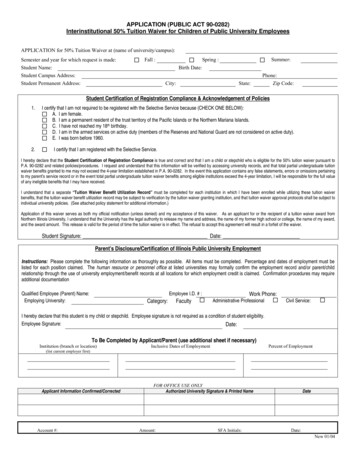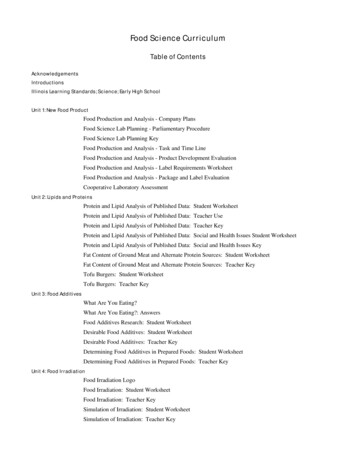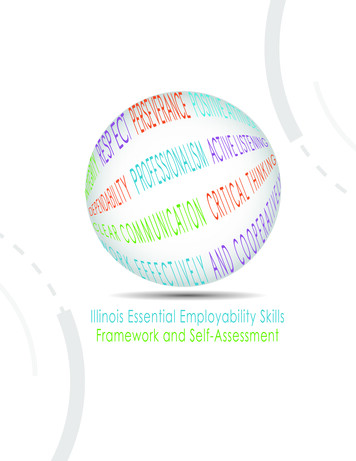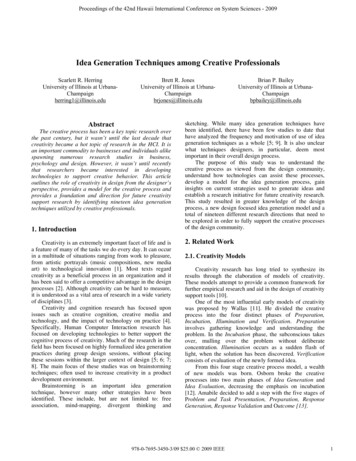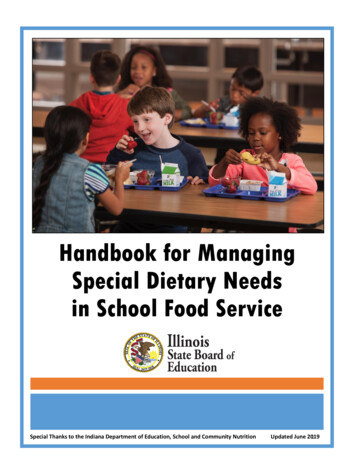
Transcription
Handbook for ManagingSpecial Dietary Needsin School Food ServiceSpecial Thanks to the Indiana Department of Education, School and Community NutritionUpdated June 20191
TABLE OF CONTENTSOVERVIEW . 4NONDISCRIMINATION LEGISLATION . 4AMERICANS WITH DISABILITIES ACT (ADA) AND ADA AMENDMENTS ACT (ADAA). 4INDIVIDUALS WITH DISABILITIES EDUCATION ACT (IDEA) . 4USDA NONDISCRIMINATION REGULATIONS (7 CFR 15B) . 6SECTION 504 OF THE REHABILITATION ACT OF 1973 . 7REQUIREMENTS FOR MEAL MODIFICATIONS . 10CHILDREN WITHOUT DISABILITIES . 10CHILDREN ELIGIBLE FOR FREE AND REDUCED-PRICE MEALS . 10REQUIRED DOCUMENTATION FOR MEAL MODIFICATIONS . 11PROCEDURES FOR MEAL MODIFICATIONS . 11COMMUNICATING WITH FAMILIES . 12DECLINING A REQUEST . 12DISCONTINUING A REQUEST . 13PROCEDURAL SAFEGUARDS . 13DISABILITY/PHYSICAL IMPAIRMENT WITHIN THE MEAL PATTERN . 14CARBOHYDRATE COUNTS . 14FOOD ALLERGY. 15FOOD INTOLERANCE . 16GLUTEN SENSITIVITY . 16CELIAC DISEASE . 17DISABILITY/PHYSICAL IMPAIRMENT OUTSIDE THE MEAL PATTERN . 17DIFFERENT PORTION SIZES . 18TUBE FEEDINGS . 18ADMINISTERING FEEDINGS . 18PHENYLKETONURIA (PKU) . 18CASES THAT COULD BE MANAGED WITHIN OR OUTSIDE OF THE MEAL PATTERN . 19TEXTURE MODIFICATIONS . 19TEMPORARY DISABILITIES . 19SPECIFIC BRANDS OF FOOD . 20MILK . 20MILK SUBSTITUTE RULE . 20DISABILITY/PHYSICAL IMPAIRMENT WITHIN THE MEAL PATTERN FOR MILK . 20DISABILITY/PHYSICAL IMPAIRMENT OUTSIDE THE MEAL PATTERN FOR MILK . 212
RELIGIOUS OR LIFESTYLE CHOICE. 21GENERAL GUIDELINES FOR MILK . 21LACTOSE-REDUCED AND LACTOSE-FREE MILK . 21NONDAIRY MILK SUBSTITUTES . 22GENERAL GUIDELINES . 22APPROPRIATE EATING AREAS . 22OFFER VERSUS SERVE . 23NUTRITION INFORMATION . 23FOOD SERVICE MANAGEMENT COMPANY/VENDED MEALS CONTRACTS . 23MEAL REIMBURSEMENT AND COST . 24PRICE OF MEALS. 24ALLOWABLE COSTS . 24COMMUNICATING WITH SCHOOL FOOD SERVICE PERSONNEL . 24STORAGE AND UPDATES OF MEDICAL STATEMENTS . 25FOOD SAFETY. 25LABEL READING . 26POLICIES FOR MEAL MODIFICATIONS . 26STRATEGIES FOR POLICY DEVELOPMENT . 27GLOSSARY . 293
OverviewThe school food authority (SFA) for each school and institution that participates in the U.S. Department ofAgriculture (USDA) school nutrition programs must comply with the federal requirements for accommodatingchildren with special dietary needs. The USDA school nutrition programs include the: National School Lunch Program (NSLP); School Breakfast Program (SBP); Afterschool Snack Program (ASP) of the NSLP; Special Milk Program (SMP); Fresh Fruit and Vegetable Program (FFVP); and Child and Adult Care Food Program (CACFP) At-risk Supper Program implemented in schools.This guide summarizes the federal laws and USDA policies that determine these requirements along with bestpractices and developed by the Indiana Department of Education who graciously shared with Illinois StateBoard of Education (ISBE). It includes recent USDA guidance that updates the requirements for mealmodifications in the NSLP, SBP, ASP, SMP, FFVP, and CACFP At-risk Supper Program, as indicated in: USDA Memo SP 26-2017: Accommodating Disabilities in the School Meal Programs: Guidance andQuestions and Answers (Q&As); and USDA Memo SP 59-2016: Policy Memorandum on Modifications to Accommodate Disabilities in theSchool Meal Programs.Due to the complicated nature of some issues regarding feeding children with special dietary needs, SFAs areencouraged to contact ISBE for assistance with any questions or concernsNondiscrimination LegislationFederal nondiscrimination laws and regulations contain provisions that require schools and institutions tomake reasonable meal modifications on a case-by-case basis for children whose disability/limitation restrictstheir diet. These laws include:Americans with Disabilities Act (ADA) and the ADA Amendments Act (ADAAA)The Americans with Disabilities Act (ADA) prohibits discrimination against any individual with a disability andextends the Section 504 requirements into the private sector. The ADA contains a definition of "individualwith a disability" that is almost identical to the Section 504 definition. The ADA also provides a definition ofwhat “substantially limits” (42 U.S.C. § 12101 et seq.; 29 C.F.R. § 1630 et seq.) entails.The Americans with Disabilities Act Amendments Act (ADAAA) made significant changes to the ADA’sdefinition of disability by broadening what qualifies as a "disability" and limiting consideration of thecorrective effects of alleviating measures (i.e., medication or learned behavioral modifications). The ADAAAalso overturned a series of U.S. Supreme Court decisions that interpreted the Americans with Disabilities Actin a way that made it difficult to prove that impairments were a disability. These amendments to the ADAmake it easier for a person with severe food allergies to qualify for protection under the ADA.Individuals with Disabilities Education Act (IDEA)School districts are required to provide special education and related services to students who are covered bythe Individuals with Disabilities Education Act (IDEA). IDEA is different from the ADA and Section 504,because it relates to the accommodations a school must make in the individualized education and curriculumof a student with a disability, not just the ability of the student to attend school classes and activities withother students. A qualifying disability under Part B of IDEA is different than the term disability under Section4
504. Under IDEA, a student with a disability means: 1) the student was evaluated in accordance with IDEA, 2)has one or more of the recognized thirteen disability categories, and 3) because of the qualifying disabilityrequires special education and related services. The disability categories include, autism, deaf-blindness,deafness, emotional disturbance, hearing impairment, intellectual disability (mental retardation), orthopedicimpairment, specific learning disability, speech or language impairment, traumatic brain injury, visualimpairment including blindness, and developmental delay (3- to 8-year-old children only).When a student qualifies for special education and related services (which could be nutrition) under IDEA,schools must develop an Individualized Education Program (IEP) for the student. An IEP is a written plan for astudent with a disability that that is developed, reviewed, and revised in accordance with IDEA and the U.S.Dept. of Education’s implementing regulations. Typically, students with food allergies are accommodatedthrough an Emergency Action Plan (EAP), an Individual Health Care Plan (IHCP) and/or Section 504 Plan andnot an IEP. However, food allergies may contribute to a health impairment qualifying as a disability underIDEA or some students may qualify under IDEA for services and also have a food allergy, so it is important tonote that in some unique circumstances, IDEA may be applicable in addition to Section 504 and the ADA.IDEA ConsiderationsA child with special dietary needs may be eligible for special education through IDEA (as a related service)under the category of “other health impaired” (OHI), where the special dietary needs or other healthconcerns are the primary reasons the child qualifies for services under IDEA. For example, if the dietaryneeds interfere with the child’s ability to benefit from instruction, a plan to address the child’s special dietaryneeds is a related service included in the IEP. The SFA must make the meal modifications indicated in the IEP.If the child is eligible under the OHI category, a case conference committee (CCC) will need to address theeffects of the child’s medical condition on educational performance. The CCC must also address the specialdietary needs as a related service enabling the child to benefit from the educational program. A childidentified as having a disability and receiving services under IDEA will have an IEP.It is important when nutrition is included in an IEP for children with special dietary needs. The IEP shouldcontain goals and objectives directly related to the child’s dietary needs, such as feeding goals. Themodifications and accommodations page of the IEP document should indicate any meal modifications for thechild. Nutrition services that are necessary to enable the child to benefit from instruction must be written asa related service for the child.If the dietary needs interfere with the child’s ability to benefit from instruction, a plan to address the child’sspecial dietary needs is a related service included in the IEP. The SFA must make the meal modificationsindicated in the IEP. However, if the special dietary issues do not affect the child’s education, anIndividualized Health Care Plan (IHCP) may be all that is necessary.5
ScenarioChild has disability but no IEPA medical statement for a childwith a disability requires six cansof a nutrition supplement duringthe school day, including two cansat breakfast, one can as a midmorning snack, two cans at lunch,and one can as a mid-afternoonsnack.The child does not have an IEP.Is the SFA required toprovide and pay for all sixservings?Child has disability and IEPA medical statement for a childwith diabetes requires a specialmid-morning and mid-afternoonshake to help stabilize bloodsugars. The child has an IEP thatspecifies this accommodation.Is the SFA required toprovide and pay for thesemid-morning and midafternoon shakes?Are Special Foods Required?No. The general guideline in making accommodations is that childrenwith disabilities must be able to participate in and receive the samebenefits as the children without disabilities. The SFA must provide andpay for the nutrition supplements at breakfast and lunch as part of thereimbursable meal.For example, if the school participates in the SBP and the NSLP, theSFA is responsible for purchasing and serving the required nutritionsupplements as part of the child’s reimbursable meal at breakfast(two cans) and lunch (two cans).However, the SFA is not required to provide the supplements forthe child’s snacks (one can in the mid-morning and one can in themid-afternoon) because they are outside of the USDA reimbursablemeal service.Yes. Since the child has an IEP, the LEA must make the specifiedaccommodations at no cost to the family, as part of school meals andoutside of school meals. The SFA is required to provide and pay forthe between meal supplements as part of the regular reimbursablemeal service.If the special nutrition supplement is required at times outside of theUSDA reimbursable meal program, the cost may be charged to theSFA. While this is an allowable cost to the school food serviceprogram, there may be alternate funding sources that can cover thecost.USDA Nondiscrimination Regulations (7 CFR 15b)The USDA nondiscrimination regulations (7 CFR 15b) and regulations for school nutrition programs (7 CFR210.10(m) and 7 CFR 220.8(m)) require that SFAs make reasonable modifications on a case-by-case basis forchildren whose disability restricts their diet. A “reasonable modification” is a change or alteration in policies,practices, and/or procedures to accommodate a disability that ensures children with disabilities have equalopportunity to participate in or benefit from a program. The general guideline in making accommodations isthat children with disabilities must be able to participate in and receive benefits from programs that areavailable to children without disabilities.Meal modifications must be related to the disability or limitations caused by the disability and require amedical statement from a state-licensed healthcare professional who is authorized to write medicalprescriptions under state law. According to 225 ILCS 85/3, prescriptions must be issued by one of thefollowing in the state of Illinois: physician licensed to practice medicine in all branches, physician’s assistant(in accordance with subsection (f) of Section 4), or an advanced practice registered nurse (APRNs) (inaccordance with subsection (g) of section 4.6
For schools participating in a federally-funded student nutrition program, USDA regulations 7 CFR Part 15brequire substitutions or modifications in school meals for students whose disabilities restrict their diets. Astudent with a disability must be provided substitutions in foods when that need is supported by a statementsigned by a licensed health care provider. The physician's statement must identify: the student's disability; an explanation of why the disability restricts the student's diet; the major life-activity affected by the disability; the food or foods to be omitted from the student's diet; and the food or choice of foods that must be substituted.Section 504 of the Rehabilitation Act of 1973 (Section 504)Section 504 prohibits all programs and activities receiving federal financial assistance from discriminatingagainst children with disabilities, as defined in the law. The USDA regulations for school nutrition programs (7CFR 210.10(m) and 7 CFR 220.8(m)) require reasonable meal modifications for children whose disabilityrestricts their diet, based on a written medical statement signed by a recognized medical authority. Requestsfor a reasonable meal modification must be related to a child’s disabling condition.If qualified for a 504 Plan, a student is entitled to receive a free, appropriate public education (FAPE),including related services. These services should occur within the student’s usual school setting with as littledisruption as possible to the school’s and student’s routines. It should be done in a way that ensures that thestudent with a disability is educated and able to participate in school activities to the maximum extentpossible with the student’s non-disabled peers. Schools must develop a plan to accommodate students whoqualify under Section 504, therefore known as a “504 Plan”. The FAPE standard is generally satisfied byfollowing The U.S. Department of Education’s implementing regulations for the Individuals with DisabilitiesEducation Act (IDEA), which refer to “handicapped” persons.Office for Civil Rights LettersThe Office for Civil Rights (OCR) promotes and ensures that people have equal access to and opportunity toparticipate in certain federally funded programs without facing unlawful discrimination. Two of OCR’s legalauthorities include Section 504 and Title II of the ADA. At times, OCR provides letters, which can be used byschool districts for guidance. These letters, however, are not published, but may be available where theyhave been submitted for publication in a private service or posted on an Internet site.Under Section 504 of the Rehabilitation Act and the ADA, a “person with a disability” means any person who1) has a physical or mental impairment that substantially limits one or more major life activities, 2) has arecord of such an impairment, or 3) is regarded as having such an impairment. Within the school setting, it israre to have a child qualify for services under parts 2 and 3 of the definition.The final rule (28 CFR Parts 35 and 36) for the ADA Amendments Act includes examples of diseases andconditions that may qualify an individual for protection under Section 504 or the ADA. This list is not allinclusive but includes orthopedic, visual, speech, and hearing impairments, cerebral palsy, epilepsy, musculardystrophy, cancer, heart disease, diabetes, intellectual disability, emotional illness, Attention DeficitHyperactivity Disorder (ADHD), Human Immunodeficiency Virus (HIV) infection (whether symptomatic orasymptomatic), and drug addiction and alcoholism. Note: An individual who is currently engaging in theillegal use of drugs, when a school district acts based on such use, is not a protected individual with adisability under either Section 504 or the ADA. This exclusion does not include individuals currentlyparticipating in, or who have successfully completed, a supervised drug rehabilitation program and are nolonger engaging in such drug use.The final rule for the ADA Amendments Act defines “major life activities” as including, but not being limitedto, caring for oneself, performing manual tasks, seeing, hearing, eating, sleeping, walking, standing, sitting,7
reaching, lifting, bending, speaking, breathing, learning, reading, concentrating, thinking, writing,communicating, interacting with others, and working. “Major life activities” also include the operation of amajor bodily function including, but not limited to, functions of the immune system, special sense organs andskin, normal cell growth, and digestive, genitourinary, bowel, bladder, neurological, brain, respiratory,circulatory, cardiovascular, endocrine, hemic, lymphatic, musculoskeletal, and reproductive systems. Theoperation of a major bodily function includes the operation of an individual organ within a body system.The ADA Amendments Act specifically prohibits an “alleviating measure” from being used to deny anindividual with a disability protection under Section 504. For example, if a child’s diabetes can be controlledthrough insulin and diet, the child may still qualify for protection because the alleviating measures (insulin)cannot be considered in determining qualification. However, the Section 504 team may use alleviatingmeasures to determine the accommodations needed for the child.Section 504 ConsiderationsThe determination of whether a child has a disability under Section 504 is through a Section 504 meeting,which can be initiated by anyone. A team of professionals who are knowledgeable about the condition of thechild reviews the child’s data, determines if additional information is needed, and determines if the childqualifies as having a disability under Section 504.Multidisciplinary Team InvolvementThe 504 Coordinator must bring together a team that includes a variety of school staff. The team mayinclude, but is not limited to: Administrative representative(s) Coaches and physical education teachers Custodial staff Food service director/staff Parent/Guardian of student School counselor/Social worker/Guidance counselor(s) School health professional Teachers Transportation staff Other learning support staff and aides, based on the student's curriculum and activitiesThe Section 504 Team determines whether the disability affects the child’s diet, and therefore requires ameal modification. This group represents each of the teaching, administrative, and school personnel staffwho participate equally in the decision-making process to:1) determine the specific educational needs of a child eligible for special education; and2) develop an IEP for the child. These are people knowledgeable in the areas necessary to determineand review the appropriate educational program for a child eligible for special education.Developing 504 PlanWhen a school receives notice that a student has a disability or impairment, it must perform an investigationby gathering certain documents, information, and medications from the parent/guardian of the student inorder to develop and implement the 504 Plan or the IHCP. The school should look in to information such as: Emergency Action Plan (EAP) Medical Statement Form Parent or guardian's signed consent to share information with other school staff. A minimum of one up-to-date epinephrine auto-injector. However, two or more epinephrine autoinjectors could be suggested based on the student's activities and movement/travel throughout theschool day.8
All other necessary medications for the student during the school day, such as antihistamines andasthma medications Description of the student's past reactions, including triggers and warning signs for allergies. Age-appropriate ways to include the student in planning for care/implementing the plan. IEPs Special Education Reports*Note that additional information may be requiredIf the team determines the child has a disability under Section 504 (because the child has a physical or mentalimpairment that substantially limits a major life activity), the SFA must make the modifications specified bythe recognized medical authority in the child’s Section 504 plan. There does not have to be an impact oneducation for a child with special dietary needs to qualify under Section 504. A child with special dietaryneeds may qualify under Section 504 if the dietary needs significantly impair the child’s major life activity ofeating. Accommodations to address the child’s dietary needs should be written into a Section 504 plan. Aseparate Individualized Health Care Plan (IHCP) may be written for the child. In some situations, the IHCP isthe child’s Section 504 plan.If the Section 504 meeting determines that the child does not have a disability, the SFA could choose toaccommodate the child, but would not be legally obligated to do so.For children with special dietary needs, the IEP may contain goals and objectives directly related to the child’sdietary needs, such as feeding goals. In the related service area, the IEP may indicate what school healthservices the child needs when the special dietary needs are considered. In addition, the modifications andaccommodations page of the IEP document should indicate any meal modifications for the child. Servicesthat are necessary to enable the child to benefit from instruction must be written as a related service for thechild.If the dietary needs interfere with the child’s ability to benefit from instruction, a plan to address the child’sspecial dietary needs is a related service included in the IEP. The SFA must make the meal modificationsindicated in the IEP.If a child is not eligible for special education nor qualifies under Section 504, school nurses may choose towrite an IHCP to address the child’s nutrition needs.9
Requirements for Meal ModificationsThe USDA regulations for school nutrition programs require that all meals served to children must complywith the meal patterns and dietary specifications (nutrition standards). SFAs are encouraged to follow themeal pattern to the greatest extent possible. However, food substitutions and other reasonablemodifications to the meal patterns may be necessary to meet the dietary needs of children who: qualify as having a disability under any of the federal nondiscrimination laws; are eligible for special education under IDEA; or do not qualify as having a disability under any of the federal nondiscrimination laws but have otherspecial dietary needs.Examples of possible modifications include food restrictions, substitutions, texture changes (pureed, ground,chopped, or thickened liquids), increased or decreased calories, and tube feedings. Modifications to the mealservice may also involve ensuring facilities and personnel are adequate to provide necessary services.In certain situations, disability accommodations may require additional equipment, separate or designatedstorage or preparation areas, surfaces, or utensils, and specific staff training and expertise. For example,some children may require the physical assistance of a food service aide to consume their meal, while otherchildren may need assistance tracking their dietary intake, such as carbohydrate intake for children withdiabetes.Children without DisabilitiesThe USDA regulations for school nutrition programs (7 CFR 210.10(m) and 7 CFR 220.8(m)) allow, but do notrequire, meal modifications for children whose special dietary needs do not constitute a disability, includingthose related to religious or moral convictions, general health concerns, and personal food preferences, suchas a preference that a child eats a gluten-free diet because a parent believes it is better for the child. SFAsmay choose to make these accommodations. If an SFA elects to make substitutions for one student, the sameaccommodation should be made for all students with that religious or lifestyle choice. For example, theschool decides to modify the meal for religious purposes for those individuals that cannot eat meat on Friday,while still meeting the meal pattern. All students due to a religious reason who cannot eat meat on Fridayshould be provided this accommodation within the meal pattern.If implementing this option, the accommodation must fit within the meal pattern and no docume
schools must develop an Individualized Education Program (IEP) for the student. An IEP is a written plan for a student with a disability that that is developed, reviewed, and revised in accordance with IDEA and the U.S. Dept. of Education's implementing regulations. Typically, students with food allergies are accommodated
